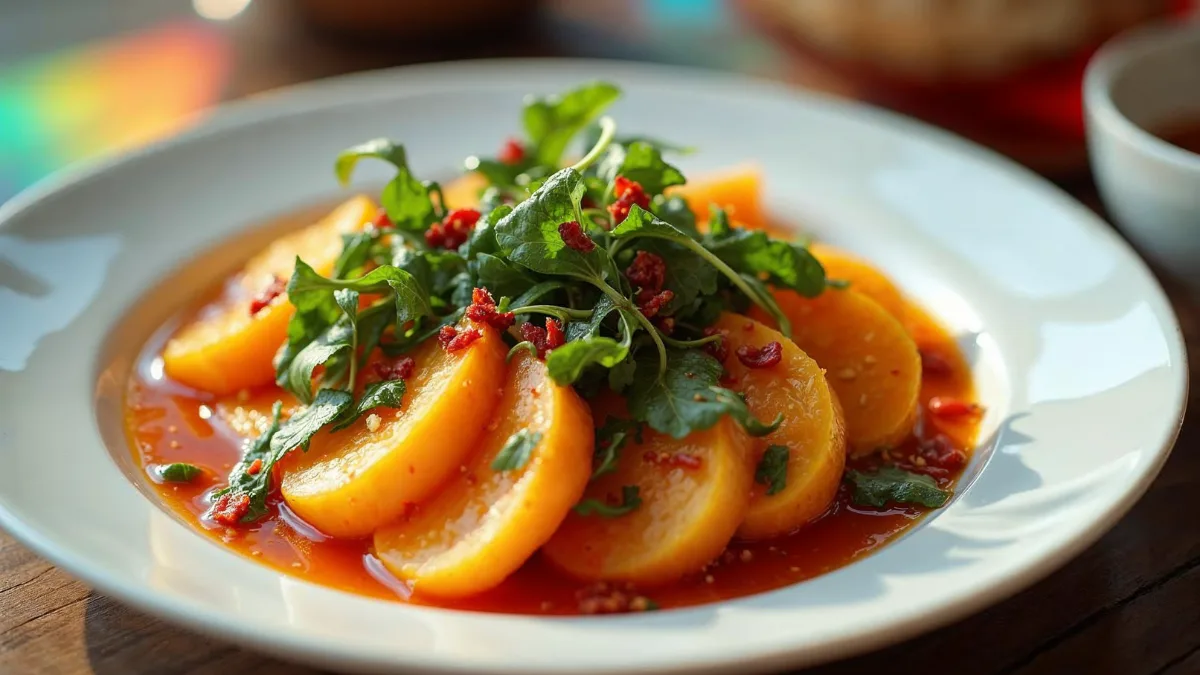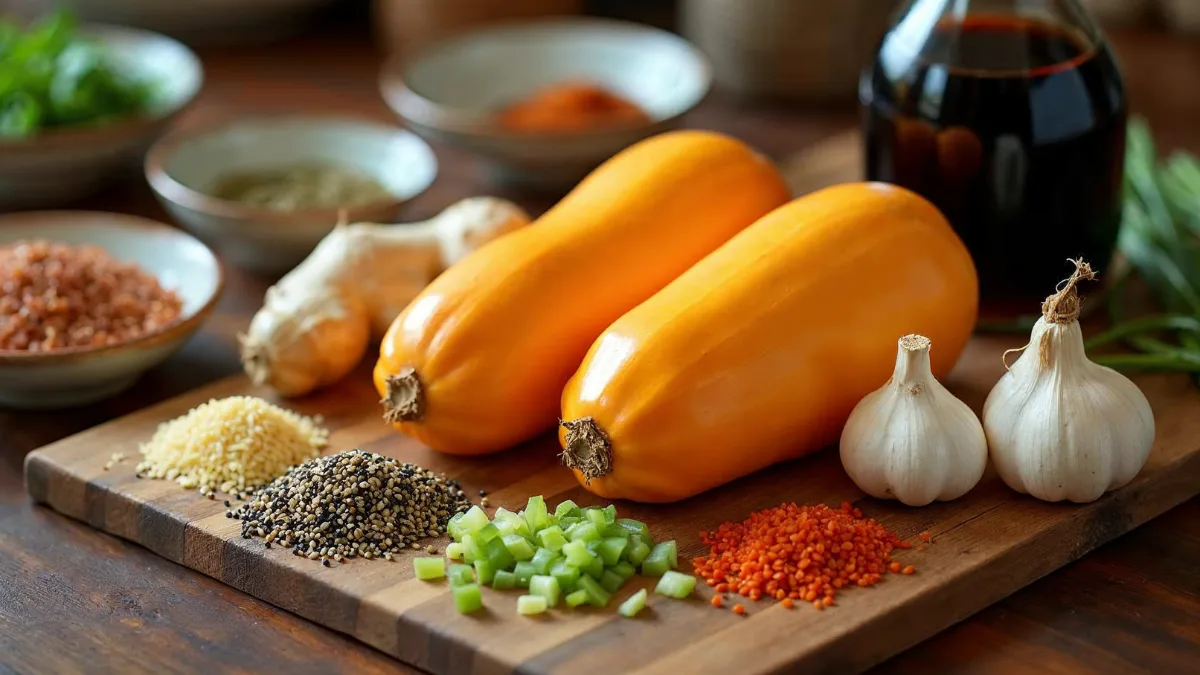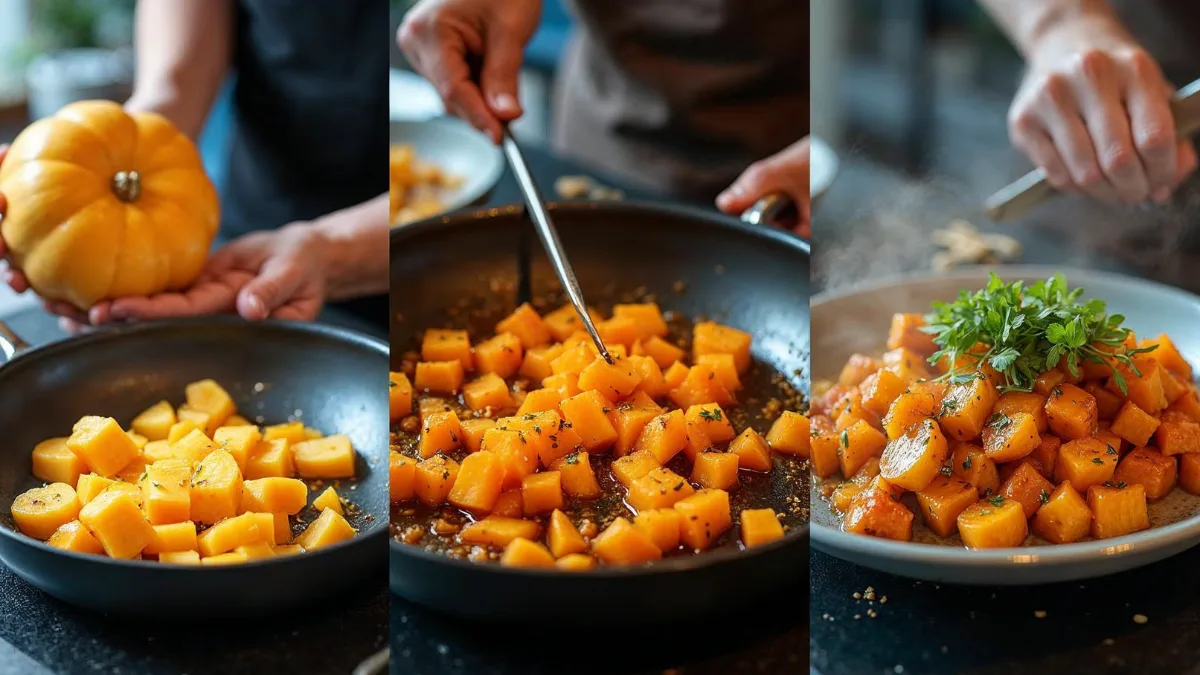I’ll never forget the first time I tried Kabocha squash in a vegan dish at a friend’s house. It was a cozy evening, and we were sitting around the table, savoring a warm, comforting bowl of stew. As I took my first bite, the sweet, earthy flavor of the Kabocha squash blended perfectly with the savory seasonings. It was a simple, yet unforgettable dish. Ever since that evening, I’ve been exploring new ways to cook with this incredible squash, especially in Chinese squash recipes Kabocha vegan.

If you’ve never cooked with Kabocha squash before, you’re in for a treat. This variety of squash is not only delicious but also incredibly versatile. Its rich texture makes it a perfect base for vegan recipes, especially when combined with other vegetables or seasonings. In this article, we’ll dive into a flavorful Chinese-inspired squash recipe that will elevate your plant-based meals. Let’s get started!
Table of contents
Why You’ll Love This chinese squash recipes kabocha vegan
This Chinese-inspired Kabocha squash recipe is a game-changer for vegan meals. First of all, Kabocha squash is known for its naturally sweet, creamy texture, which makes it a perfect addition to any vegan dish. Additionally, this recipe is packed with vibrant flavors, from the savory garlic and ginger to the umami-rich soy sauce. What makes it even better is how easy it is to prepare. You’ll be able to enjoy a hearty, flavorful meal in no time. Plus, Kabocha squash is full of nutrients, including vitamin A and fiber, making this dish not only delicious but healthy too. Whether you’re a long-time fan of plant-based meals or just getting started, this recipe will quickly become a favorite in your kitchen. It’s a simple yet satisfying way to enjoy a flavorful vegan meal, perfect for any occasion.
Ingredients for chinese squash recipes kabocha vegan
To make this delicious and vibrant Chinese-inspired Kabocha squash vegan recipe, you will need the following ingredients:

- 1 medium Kabocha squash
- Look for a firm squash with a deep green, slightly orange skin. This is the star of the dish, offering sweetness and creaminess.
- 2 tablespoons sesame oil
- Sesame oil adds a nutty and aromatic flavor to the dish, complementing the sweetness of the squash.
- 3 cloves garlic, minced
- Fresh garlic adds depth and a savory kick to balance the sweetness of the squash.
- 1 tablespoon fresh ginger, grated
- Ginger brings a zesty, slightly spicy kick that enhances the dish’s flavor profile.
- 2 tablespoons soy sauce (or tamari for gluten-free)
- Soy sauce provides a salty, umami-rich base. Tamari can be used for a gluten-free version.
- 1 teaspoon rice vinegar
- Rice vinegar adds a tangy, slightly sweet note that brightens the dish.
- 1/2 teaspoon Chinese five-spice powder
- This aromatic spice blend adds a complex and fragrant flavor, making the dish truly unique.
- 1/4 cup vegetable broth or water
- Use vegetable broth for a richer flavor or water to keep it lighter.
- 1/4 cup chopped scallions (for garnish)
- Garnish with fresh scallions to add a mild, onion-like crunch to the dish.
- 1 tablespoon toasted sesame seeds (optional)
- Sesame seeds offer a light crunch and enhance the nutty flavor of the sesame oil.
With these simple ingredients, you can create a perfectly balanced, flavorful vegan dish that is both satisfying and healthy. Enjoy the vibrant flavors and nutrient-packed goodness of Kabocha squash!
How to Make chinese squash recipes kabocha vegan
Follow these simple steps to create a flavorful and satisfying Chinese-inspired Kabocha squash vegan recipe:

- Prepare the Kabocha Squash
- Peel and cube the Kabocha squash into bite-sized pieces. Remove the seeds before cooking for a smoother texture.
- Heat the Sesame Oil
- In a large skillet, heat 2 tablespoons of sesame oil over medium heat until fragrant.
- Sauté Garlic and Ginger
- Add the minced garlic and grated ginger to the skillet. Sauté for 1-2 minutes until fragrant, stirring frequently.
- Cook the Squash
- Add the cubed Kabocha squash to the skillet. Stir to coat in the oil, garlic, and ginger mixture.
- Add Soy Sauce and Rice Vinegar
- Pour in the soy sauce and rice vinegar, stirring to evenly coat the squash. Cook for another 3-4 minutes.
- Season with Chinese Five-Spice Powder
- Sprinkle in 1/2 teaspoon of Chinese five-spice powder. Stir to evenly distribute the spices, enhancing the flavor.
- Simmer with Broth
- Add 1/4 cup vegetable broth or water to the skillet. Cover and simmer for 10-12 minutes, until the squash softens.
- Adjust Seasoning to Taste
- Taste and adjust the seasoning with additional soy sauce, vinegar, or five-spice powder if needed.
- Garnish and Serve
- Transfer the squash to a serving dish. Garnish with chopped scallions and optional toasted sesame seeds.
Tips for the Perfect Dish:
- For extra flavor, sauté the squash in batches to prevent overcrowding in the pan.
- You can substitute tamari for soy sauce for a gluten-free version.
- Adjust the cooking time based on the size of your squash cubes for optimal tenderness.
Enjoy this flavorful and easy Chinese-inspired Kabocha squash vegan recipe!
How to Store chinese squash recipes kabocha vegan
Refrigerating Chinese-Inspired Kabocha Squash Vegan Recipe
To store leftovers, transfer the cooled Kabocha squash into an airtight container. Refrigerate for up to 3-4 days. When ready to eat, reheat in a skillet over medium heat, adding a splash of water or broth to prevent dryness. Alternatively, you can microwave it in 30-second intervals until warmed through. Avoid reheating multiple times to maintain flavor and texture.
Can You Freeze Chinese-Inspired Kabocha Squash Vegan Recipe?
Yes, you can freeze this dish. To do so, allow it to cool completely before transferring it to a freezer-safe container or zip-top bag. For best results, consume within 1-2 months. To thaw, place the dish in the refrigerator overnight, and reheat it in a skillet or microwave. Adding a little water or broth during reheating can help retain moisture and prevent it from becoming too dry.
Serving Suggestions for chinese squash recipes kabocha vegan
Perfect Pairings for Chinese-Inspired Kabocha Squash Vegan Recipe
This flavorful vegan dish pairs wonderfully with a variety of sides. For a balanced meal, consider serving it alongside steamed jasmine rice or quinoa to absorb the delicious sauce. You could also add a simple side of sautéed greens, like spinach or bok choy, for a burst of color and nutrients. If you’re craving something heartier, pair it with crispy tofu or tempeh for an added protein boost.
Presentation Tips for Chinese-Inspired Kabocha Squash Vegan Recipe
For an eye-catching presentation, serve the squash in individual bowls, garnished with fresh cilantro, sesame seeds, or chopped green onions. You can also add a sprinkle of chili flakes for a pop of color and spice. Consider using colorful plates to enhance the vibrant hues of the squash and sauce.
Variations for Different Occasions or Preferences
This recipe is highly versatile. For a festive meal, try adding roasted peanuts or cashews for crunch. If you prefer a spicier kick, increase the amount of chili or add a dash of sriracha. For a gluten-free version, simply substitute tamari for soy sauce. The Chinese-Inspired Kabocha Squash Vegan Recipe can be enjoyed year-round, making it an ideal dish for both casual dinners and holiday feasts.
Mistakes to Avoid When Making Chinese-Inspired Kabocha Squash Vegan Recipe
Overcooking the Squash
One common mistake when making the Chinese-Inspired Kabocha Squash Vegan Recipe is overcooking the squash. While it should be tender, cooking it too long can cause it to turn mushy. To avoid this, make sure to check the squash for doneness by gently piercing it with a fork. It should be soft but still hold its shape.
Using Too Much Oil
Another error is using too much oil in the cooking process. While oil helps to sauté the ingredients, using too much can make the dish greasy. Stick to the recommended amount to ensure the sauce and squash maintain the right consistency. If needed, you can always add a splash of vegetable broth for extra moisture without the extra fat.
Forgetting to Balance Flavors
Balancing the flavors in this recipe is essential. A common mistake is not adjusting the seasoning to taste. If you find the dish too salty, consider adding a dash of rice vinegar or lime juice to balance out the richness. Taste-testing along the way ensures a well-rounded flavor profile.
Skipping the Garnishes
Garnishes are not just for decoration; they bring additional flavors and textures to the dish. Skipping fresh herbs, like cilantro, or a sprinkle of sesame seeds, can lead to a lack of depth in flavor. Don’t skip this final touch—it will make your dish look more appealing and taste even better!
By being mindful of these tips, you can easily avoid common mistakes and create a perfectly balanced, delicious Chinese-Inspired Kabocha Squash Vegan Recipe.
Nutritional Breakdown for Chinese-Inspired Kabocha Squash Vegan Recipe
| Nutrient | Amount per Serving (1 cup) |
|---|---|
| Calories | 140 kcal |
| Protein | 3g |
| Total Fat | 6g |
| – Saturated Fat | 1g |
| – Unsaturated Fat | 5g |
| Carbohydrates | 23g |
| – Dietary Fiber | 4g |
| – Sugars | 5g |
| Vitamins & Minerals | |
| – Vitamin A | 105% DV |
| – Vitamin C | 45% DV |
| – Calcium | 4% DV |
| – Iron | 8% DV |
| Sodium | 300 mg |
| Cholesterol | 0 mg |
| Dietary Notes | Vegan, Gluten-Free |
- Calories: This dish is light, with only 140 kcal per serving, making it a great option for those watching their calorie intake.
- Protein: While not a high-protein dish, it provides 3g of protein per serving, thanks to the squash and seasonings.
- Fats: A good amount of healthy fats (6g) from sesame oil and seeds, helping to absorb fat-soluble vitamins.
- Carbohydrates: The dish provides 23g of carbs, including 4g of fiber, which aids digestion and provides lasting energy.
- Vitamins & Minerals: Rich in vitamin A and C, this recipe supports immunity and skin health. It also provides a modest amount of iron and calcium.
- Dietary Notes: Perfect for those following a vegan or gluten-free diet.
This nutritional breakdown makes the Chinese-Inspired Kabocha Squash Vegan Recipe a healthy and flavorful choice for any meal.
FAQs
1. Can I use other types of squash in this recipe?
Yes, you can substitute kabocha squash with other varieties like butternut or acorn squash. However, kabocha gives a unique texture and flavor that’s hard to replicate.
2. How do I store leftovers of this Chinese-Inspired Kabocha Squash Vegan Recipe?
Store leftovers in an airtight container in the refrigerator for up to 3 days. Reheat gently in a skillet or microwave.
3. Is this recipe suitable for meal prepping?
Absolutely! This recipe is perfect for meal prep. Simply store individual portions in containers and reheat throughout the week for a quick and nutritious meal.
4. Can I add protein to this dish?
Yes! Tofu, tempeh, or chickpeas are great vegan protein additions. You can sauté or roast them alongside the squash for added flavor.
Conclusion
In conclusion, this Chinese-Inspired Kabocha Squash Vegan Recipe is a must-try for anyone looking to enjoy a healthy and flavorful meal. With its perfect balance of savory spices, tender squash, and vibrant vegetables, it offers a delightful combination of textures and tastes. The recipe is not only vegan and gluten-free, but it’s also packed with essential vitamins and minerals, making it both nutritious and satisfying. Whether you’re a seasoned cook or a beginner, the simple steps make this dish easy to prepare, yet incredibly impressive when served.
Moreover, this dish is versatile enough to serve at any occasion, from casual weeknight dinners to special gatherings. So, why not give it a try and add a healthy, flavorful twist to your meal rotation? Don’t forget to share your results with us and explore other vegan mushroom recipes for more culinary inspiration. Happy cooking!




